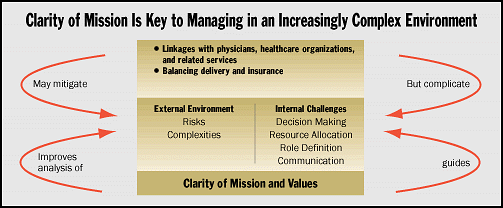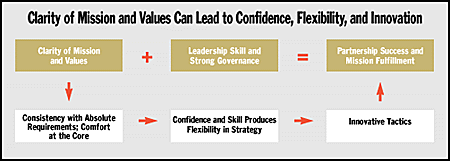A Study of Six Successful Catholic Systems Finds Mission and Values Clarity More Relevant than Ever
Convinced that Catholic organizations might have special strengths for succeeding in price-competitive markets, the Catholic Health Association, with the assistance of a national membership advisory committee and The Lewin Group, Fairfax, VA, studied six healthcare organizations that are successfully meeting the challenges of difficult environments. Based on more than 100 interviews and assessments of the environments in which these progressive mission-driven organizations operate, the researchers identified strategies that can assist other faith-based health organizations.
The Lewin Group's Kevin J. Sexton, who led the research team, explained that "the study examined how the organizations embraced their mission and used their values in three areas: linkages with other organizations, linkages with physicians, and strategies for balancing delivery and insurance." CHA's executive vice president William J. Cox said the study sites were selected to obtain a range of marketplace, sponsorship, and structural experiences. "We wanted to learn how Catholic organizations responded to environmental forces with strategies that were grounded in mission," Cox said.
CHA has published the study in a resource packet that describes the five major findings, profiles the cases, and provides Best Practices Checklists — specific pointers to guide organizations in their efforts. The following study excerpts provide a brief overview of the findings and a sample of the Best Practices Checklists. To obtain the complete resource, Mission-Driven Market Strategies: Lessons from the Field, call the Catholic Health Association at 314-253-3458.
FINDING 1: Environmental Complexity — Here Today, Here Tomorrow
Progressive Catholic healthcare organizations are extremely active in anticipating and responding to the increased risks and complexities of their healthcare environments. These responses, even as they mitigate risk, have themselves increased the challenges of decision making, role definition, resource allocation, and internal and external communication. Mission and values clarity has proven to be the best broad-gauged guide to optimal decision making in the increasingly complex and challenging milieu.
Many of the study interviewees communicated a sense of confidence and excitement about carrying out the Catholic health ministry in an immensely competitive and changing environment. They shared a sense of humility, however, about the difficulty of always knowing the best path to follow to mission fulfillment and market success. This paradox, one of many, is the result of dealing with numerous complex, difficult issues that require management but may never succumb to permanent solutions.
- Organizations in this study have found that successful market strategies breed complexity, not ease. Each of these strategies requires sharing control and working with others, which is often unpracticed and inherently complicated. Linkages are visible activities that are expensive, with high opportunity costs and even higher costs of failure. They are time-consuming and distracting, often anxiety provoking, not only for the board members, senior executives, and physicians involved directly in the discussions, but also for employees who "tend to the knitting" and carry out the day-to-day clinical and administrative work. Managing population health and integrating the insurance function within the delivery system add an even greater level of complexity to the equation.
- Successful organizations are absolutely clear on mission and core values. This clarity helps them manage complexity. Contrary to the notion that mission requirements imply organizational inflexibility, clarity about what defines an organization and what is unshakable for sponsors, board members, and senior executives actually promotes flexibility of tactics. Clarity helps an organization select its critical few strategic directions from among the important many.
- A rigorous, analytical process has proven to be helpful and necessary to obtain sufficient internal clarity of mission and values. A formal process can help establish clear agreement among the sponsors, board members, and senior management on what the organization is about (clarity of mission) and how the organization goes about accomplishing it (clarity of values).
Mission in Action The Franciscan Sisters of Perpetual Adoration (FSPA) conducted a process to clarify their own identity and state the signs they hold as marks of a Catholic institution. The FSPA's Key Indicators of Catholic Identity and Mission includes the following signs of Catholic identity for its sponsored institutions:
- Reflection of the Franciscan model and values of Christian life
- Spiritual care appropriate for the primary services for which the institutions were founded to patients, students, staff, various publics and to one another
- A knowledge of and practice of the social teachings of the Catholic Church
- The awareness and implementation of resource documents: Ethical and Religious Directives for Catholic Health Care Services and Ex Corde Ecclesiae, and,
- An exercise of the obligations defined in the corporate structure

FINDING 2: Organizational Linkages
Organizational linkages (higher risk, more costly, and more visible than almost any other strategy) have little hope for long-term success if common mission and values are not at the core of the relationship, even if a strong economic or market case appears to exist. Mission and values compatibility has emerged as an important guide to assessing, structuring, and accomplishing successful linkages.
- Progressive systems are clear about what they require in a partner; some have developed tools that assess values prospectively and rate fulfillment of ministry interests under any structural arrangement.
- A clear lesson from the field is that more time should be spent on determining absolute requirements for "partnership fit" — common values, mission compatibility, and determinants of living and working together.
- Successful Catholic healthcare organizations have found that linkages with related services and ministries can provide powerful assets but require a mutual recognition of differences in organizational culture and explicit efforts to develop a shared sense of purpose.
- Successful organizations relied on common absolute requirements of organizational partners in creating workable governance and management structures.
- The development of guiding principles for structuring linkages with organizations is a common early step among successful organizations.
- The process of structuring relationships is also important.
Best Practices Checklist for Organizational Linkages
Determining Common Values and Cultural Compatibility
- Analyze the fit of the potential partner with the partnership criteria you have developed.
- Continue to look for further evidence that your potential partner shares your values.
- Develop a list of the key interests of your health ministry.
- Review your potential partner's principles for consistency with these key interests.
FINDING 3: Physician Linkages
In response to the changing environment, institutional/physician relationships have moved closer economically and organizationally than ever before. Notwithstanding that trend, physicians desire autonomy. Development and management of physician relationships is both vital and extraordinarily difficult. Mission clarity and core values have assisted organizations in dealing with threshold issues of mutual respect, trust, and communication, as well as the tactical challenges of decision making, incentive alignment, and short-term versus long-term measurement of success.
- Successful linkages between physicians and organizations recognize differences and difficulties but build from shared values.
- Core purpose and values can be expressed in concrete ways that appeal to physicians.
- Successful organizations have the willingness and flexibility to continue to change and have undergone several significant modifications in system/physician relationships.
- Given its dynamic nature and emotional content, a clear lesson about structuring physician relationships is that physicians must be central to the design of the relationship from the beginning.
- The study revealed a consensus that physicians should be represented at the overall governance level and on board-level committees.
- The evolution of physician relationships in the past several years will continue — they are works in progress.
Best Practices Checklist for Physician Linkages
Integrating Physicians into Governance and Management
- Provide mechanisms for physicians to have a true role in governance.
- Provide mechanisms for physician roles in management.
- Create interdepartmental decision-making mechanisms that can redirect focus toward organizational rather than departmental goals.
- Maintain a high degree of interest in identifying and developing physicians who are capable of leadership in a significant way and who are interested in providing leadership.
FINDING 4: Balancing Delivery and Insurance
Developing fully integrated delivery and financing systems produces inherent conflict and resource allocation complexities that are difficult to manage. Mission and values clarity has helped organizations manage the tradeoffs in successfully balancing delivery and "insurance" while maintaining motivation and morale among caregivers.
- Some progressive organizations have found that managing population health enables them to integrate mission and business and care for vulnerable populations while employing sound business principles.
- Capitation and risk taking raise questions of role definition, resource allocation, and responsibility to patients and populations in new ways.
- Some organizations have established criteria for determining whether to start up a health maintenance organization (HMO) or to pursue participation in plans owned by others instead.
- Conflicts will be inevitable among providers and health plans, between providers themselves, and from changing legislation.
- Organizational structures are evolving to manage population health.
Best Practices Checklist for Balancing Delivery Linkages
Understanding the Complexity of Being a Provider and an Insurer
- Be prepared for the complexities of organizationally managing a vertically (and often horizontally) integrated system.
- Understand that the insurance business will require substantial funds and may divert funds from the delivery side at a time when delivery organizations are vertically and horizontally integrating.
- Be prepared for threats and material retaliation.
- Develop a single strategic plan for the organization.

FINDING 5: Leadership/System Development
These environmental and organizational responses are taking place at different paces and in sometimes fundamentally different ways across the country. Leaders at the local level, and especially national systems and sponsors, must manage the resulting governance, managerial, and fiscal stresses. A mission and values touchstone has played and will play an important role in grounding and strengthening leaders and facilitating system management of these dilemmas.
- Notwithstanding everything else, strong effective leadership is critical.
- Leaders must communicate, and then communicate more.
- Evolving governance relationships can be challenging for systems, especially for systems that operate in multiple markets. Linkages with organizations and physicians and balancing delivery and insurance require clarity of board and management roles, responsibilities, and accountabilities if the organization is to overcome the significant amount of distraction and even conflict that these strategies can produce.
Using this study as a foundation, CHA is currently conducting an assessment of partnerships between Catholic and other-than-Catholic organizations. The association will also be examining members' experiences integrating organizational cultures. "In the coming year," said CHA president Rev. Michael D. Place, STD, "the association will be seeking input on other ways we can combine lessons from multiple member organizations for use by the entire ministry."
CASE STUDY ORGANIZATIONS
Carondelet Health Network, Tucson, AZ
Franciscan Skemp Healthcare, LaCrosse, WI
North Iowa Mercy Health Center, Mason City, IA
Providence Health System in Oregon, Portland, OR
Sisters of Charity Health Care System, Houston, TX
St. Agnes HealthCare, Baltimore, MD
Interviewees were asked:
"What advice would you give to others who are pursuing organizational and physician linkages and balancing delivery insurance?" This is a sample of their responses:
- Support training opportunities for key physicians.
- Discuss pros and cons and decide about whether an incumbent CEO of one of the partners will run the new network or whether a new person will be recruited; balance the need for continuity with the need for clear allegiance to the network rather than to one of the partners.
- Don't grow management too fast in the beginning — the tendency to overstaff is hard to undo (e.g., VP for every region).
- Get to know second line managers during the negotiation process, not just the CEO.
- While the Ethical and Religious Directives codify, among other things, permissible clinical practice, they do not codify Catholic social teachings.
- Do not be afraid to let legal language err on the side of physicians.
- Be sure the physician steering committee is respected by most physicians.
- Have a joint board/administrative committee do the negotiating, not just administrators who then bring the decision to the board.
- Mission that is palpable ignites the passion — mission centers people when the world is chaotic.
